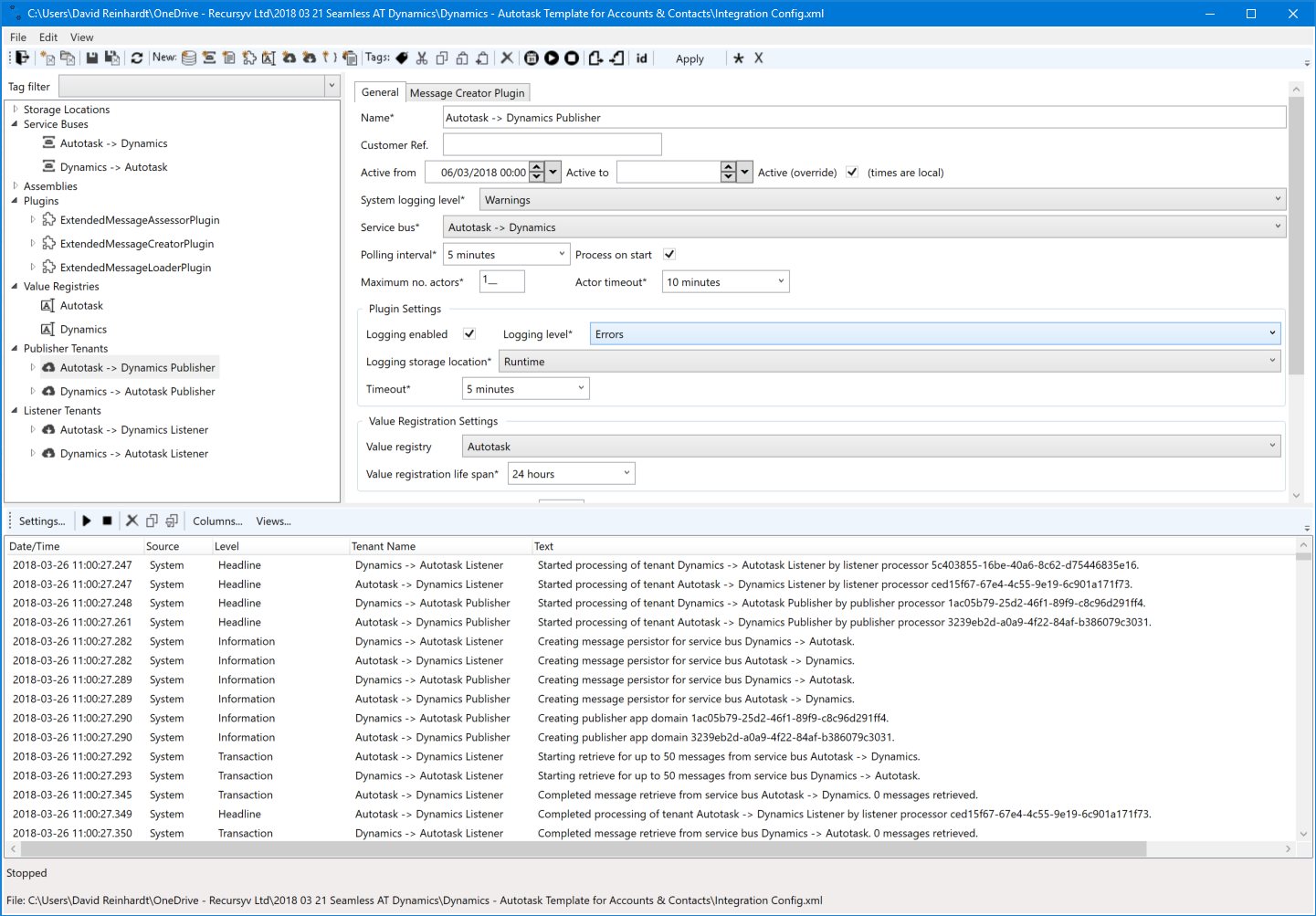Whenever we’re sharing our integration tooling with engineering teams there are two underlying takeaways that we try and demonstrate: it is quick and it is heavily configurable.
Continue readingWe’re better together – the Seamless partner programme
The Seamless integration workbench – a primer
Over the past few months, we’ve dropped a few hints about the Seamless integration workbench. In this post we wanted to share some more details about the workbench.

What’s it good for?
The workbench is all about setting up an integration configuration. An integration configuration describes everything the core Seamless service needs to sync data between different systems. Within the workbench, a user can configure all the variables that make up an integration.
- Specify the connector plugins that need to be used for this integration
- Specify any properties the plugins require in order to process data (e.g. connection details for the systems being synced)
- Specify where data in transit will be hosted (a service bus, a database, a local directory, etc.) and when it will be expired
- Specify the data queries to retrieve data from the source system
- Specify the data transforms required before posting data into the target system
- Specify the timing of data sync from source to target and vice-versa
How does it work?
All aspects of an integration are ultimately saved into an XML file. These files can be loaded into the workbench (to continue working on a previous integration) and saved from the workbench (for subsequent deployment into Seamless).
The workbench can also run the integration locally (i.e. on the local machine). This is useful for troubleshooting and debugging integrations before they’re deployed into the cloud. Integrations are run by clicking play and all logging data is provided to the user for analysis.
What can it not do?
The workbench can not do the deployment of the config file to a live Seamless service. This was kept out of the workbench to enable separation of design and deployment.
The workbench can not run the integration on an ongoing basis. Options for running locally are limited to a handful of iteration cycles. In practice, you couldn’t use the workbench to run Seamless as a locally hosted integration service.
Who gets to use the workbench?
The workbench is provided to all Seamless delivery partners so that they can work on developing integrations. The workbench is also provided to clients who want to specify and build their own integrations – often as part of a broader software project.
Does every Seamless user need to use the workbench?
No. Only delivery partners and users who are specifying their own integrations need to use the workbench. Where you’re working with a delivery partner or directly with Recursyv, you won’t have any use for it.
How did it come to be called the workbench?
You’d think the term “workbench” was a pretty straightforward moniker for this piece of kit. In the early days, our engineering team creatively labelled this the “Seamless Integration Builder” – descriptive but not particularly exciting. After many, many minutes of discussing prospective names for it, David and Jon moved onto a more pressing conversation about why cycling is a better sport than running. In conversation some months later, one of our clients referred to the tooling as “the workbench” and the name has stuck. Also, the client prefers cycling.
Microsoft Inspire – a dozen reflections
Although Inspire finished last week, I was lucky enough to take a few days to explore Washington, D.C. While pounding the pavements, I began to think about all we had seen and learnt. Although I will work through my notes in detail (hooray for OneNote), I wanted to share a few initial reflections while they were fresh in mind. They range from thoughts about our own products to how to get the best out of investing in similar conferences.
In no particular order …
- Microsoft want it to be easy for partners to engage with Microsoft. The new partner model, is about simplifying relationships with Microsoft to make it easier to build, market and sell. For a small ISV such as ourselves, this is only good news. We cannot yet tell if it will work, but the design ambition supports our business and we’re excited by that.
- Microsoft want it to be easy for SMBs to consume Microsoft products. Microsoft 365 is a significant statement of intent. An aspect of our own vision is about making it easy for SMB size customers to access enterprise class tools. In our world, this is about integration (Seamless) and Dynamics 365 (Sales In-a-Box). We’re delighted that there is broader recognition of this thinking.
- Verticalise. Verticalise. Verticalise. This is not a new theme but it certainly remains top of mind for Microsoft. As a provider of a horizontal solution (Seamless), this is a challenge for us. One of our actions is to work out how position our Seamless service into a verticalised market offering. Watch this space.
- Just chat to people. Everyone is at the conference to talk about Microsoft technologies and you have no idea whether a conversation might become an opportunity. One of our most promising opportunities was born out of a discussion about tourist highlights in D.C.
- At such a big event, you need to play to your strengths. We have a confession to make: we didn’t go to the UK Regional Party! Scandalous, I know, but both Jon and I recognised that a party style function was just one that we don’t enjoy and are unlikely to get much out of. Between ourselves, we had some doubts and we needed to convince ourselves that it was okay to play truant, but ultimately we decided there’s no sense moping around where we didn’t want to be. We took the evening to get a good pizza and discuss product ideas in the wake of what we were learning at the conference.
- Put time into the exhibition showcase. It can be easy to dismiss it as swag (more on that later) and marketing pamphlets, but we spent a few hours browsing and discussing our technologies with exhibitors. For the time we invested, we learnt about many things we hadn’t seen before and we have a few follow-up conversations to pursue.
- Swag 2017 is all about the fidget spinners. I keep on reminding Jon that I didn’t get 22 “free” fidget spinners as I paid a hefty sum to be at the conference. More seriously though, a week later I probably couldn’t name one company that gave me a fidget spinner. Without making an obvious brand message link, it seems (to me) that swag is just a waste of money. And it doesn’t have to that hard, for a fidget spinner it could be as simple as “No need to be distracted when our software is deployed.” That said, my kids are probably expert in the Microsoft ecosystem by now.
- Microsoft is an inspiring company. Yes, it sounds like I’ve been drinking the Kool Aid (in four colours, of course) but hear me out. Every major presentation starts with the mission statement and the content is aligned to the mission. There is a line of clarity from how the work we’re doing lines up to the broader mission of the company. More importantly, talk of diversity is more than empty rhetoric when there is evidence of value based behaviours all over the conference site.
- Jon and I need to make time to talk about the business. Over the past quarter I feel we’d fallen out of the habit of thinking beyond the next week or two. One of our personal reflections is that we need to be sure to separate our time between strategic considerations for our business and operational work in the coming days and weeks. The time we spent pounding the pavement across D.C. was a good reminder.
- Client experience counts. At a 4 day conference for 17 000 people, we had one hiccup (getting into the Verizon Centre for the first keynote where security lines were too long). It felt as if this had been addressed by the next day. Otherwise the whole event ran as smoothly as clockwork. This includes sessions, the expo, moving people between dozens of hotels and two conference sites, connectivity issues, pre-arranged meetings, the conference app, social events, etc. etc. It was impressive to observe and a delight to be part of.
- I look better with make-up on. According to the make-up artist at the LinkedIn stand where I had a new profile shot taken, it was to “take the shine off” and “make my hair pop”. Admittedly, the surface area for shine has grown somewhat since the last time I updated my profile pic.
- Finally, if you’re going to Inspire in Vegas next year, and we’re certainly aspiring to do so, wear comfy shoes.
PS Jon reckons that if had branded “Back to the Future” style hoverboards, we wouldn’t need to worry about the brand message as they’d just be cool. Admittedly, if we knew were to get those hoverboards, we’d probably be in the business of marketing hoverboards rather than data integrations.
The counter-intuitive benefit of shorter projects
As we’re working to build the partner network around Seamless, I am often talking through (what we believe to be) the benefits of using Seamless for delivery of integrations. We have a background in delivering IT change projects and one of our favourite Seamless benefits is that developing integrations becomes much much quicker. If we have a connector plugin already built, it is simply a matter of specifying the right fields and associated rules. If we don’t, we can often build one in under a week (assuming being reasonable API access).
For companies who make a lot of their revenue selling time (i.e. time taken by software engineers to build applications), it seems counter-intuitive that we’re touting shorter projects as a benefit. Er, what’s up with that?
Our response is simple: I’d rather you sold a 60 day project than lost a 120 day project to a competitor.
Our partners will be competing with any number of other organisations who will have different ways to deliver software. Today’s average user has experience of sophisticated web services and expects that software delivery companies can quickly connect up different services. Agile approaches add an additional dimension of expectation because clients expect to see phased delivery of packages of requirements.
Sure, reducing delivery time reduces upfront professional services revenue, but it makes our partners’ projects more commercially attractive. If this can be done in a way that also reduces risk (using technology that is proven to work) and increases flexibility (extendable plugins, a myriad of configuration options, etc.), then the offer becomes more attractive on day one (commercially) and over time (ability to adapt to inevitable business change).
Finally, let’s not lose sight of that fact that, over time, “lost” revenue may be recovered (plus more) through sharing of the subscription fee.
[icon name=”exchange” class=”” unprefixed_class=””] Learn more about partnering with Seamless. We could talk about it all day.
Splashing the big bucks, our Microsoft Inspire story (part 1 … part 2 when we’re back)
In about a month we’ll be headed off to Washington, D.C. to join the Microsoft partner community at Microsoft’s global partner conference, Inspire. Attending Inspire with something to say was always a goal for us when we set out. We knew we were working in the Microsoft world and the partner conference is the place to build a network around any Microsoft enabled business.
As you can imagine, a conference of this nature is a significant expense. There are conference tickets to be purchased, flights, accommodation, food and Hard Rock souvenir pin badges. (If Jon doesn’t read this post carefully, I’ll try expense the pins … watch this space!) Returning home with a just handful of business cards would be a significant failure. We consulted with former attendees and built out our plan. With about a month to go, we’re doing okay and I thought it might be interesting if we shared some of our thinking.



 Over the past few months, we’ve hinted at some of the tooling we’ve been working on for partners. In the last post, we
Over the past few months, we’ve hinted at some of the tooling we’ve been working on for partners. In the last post, we 



